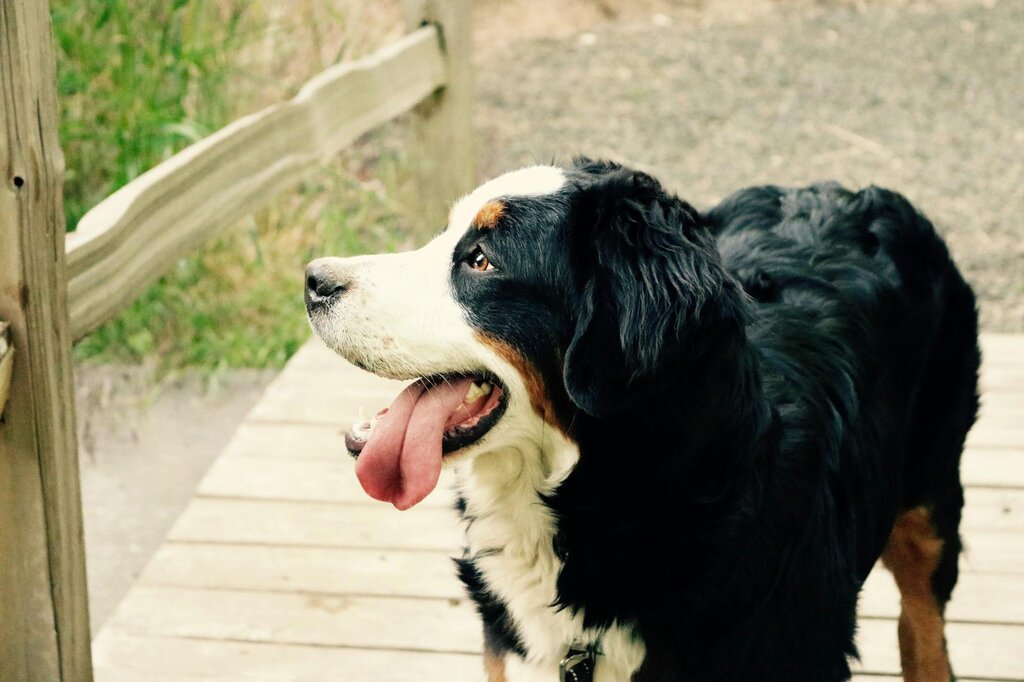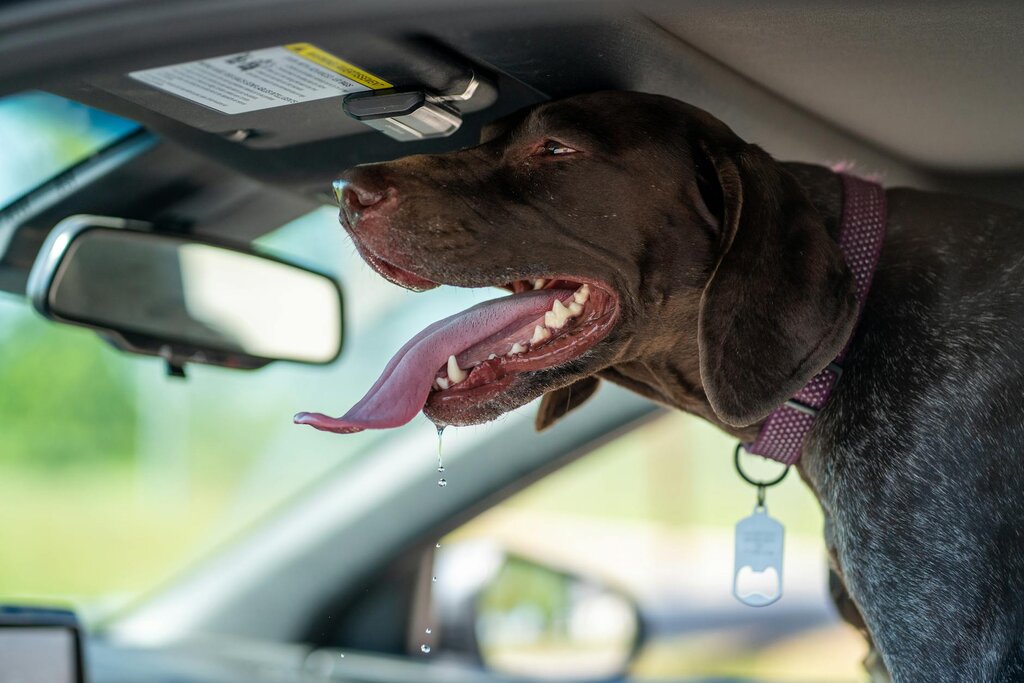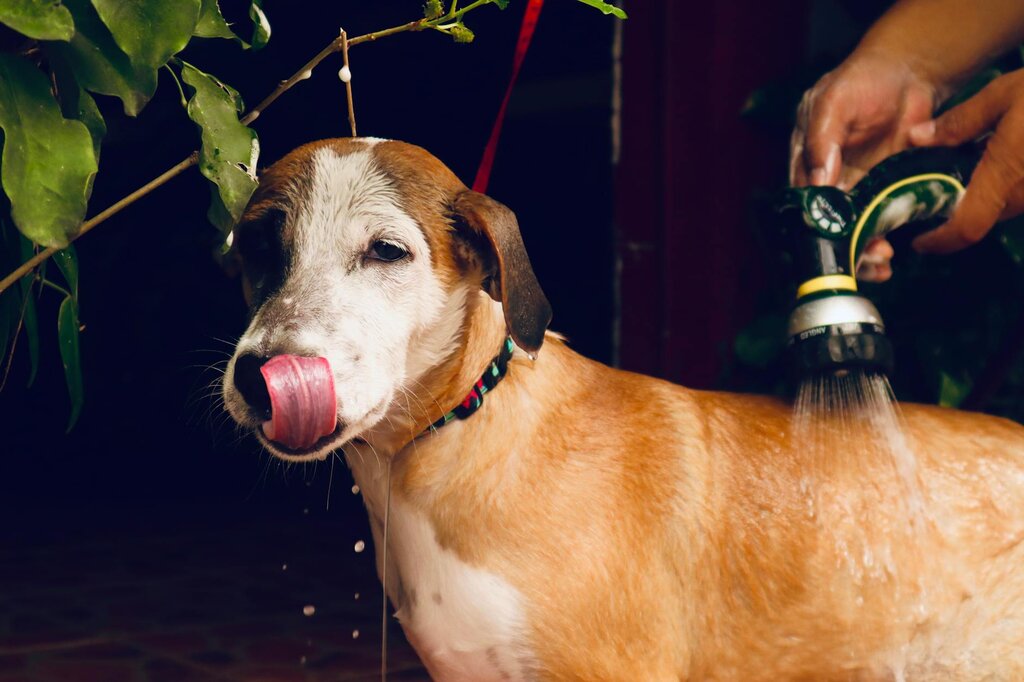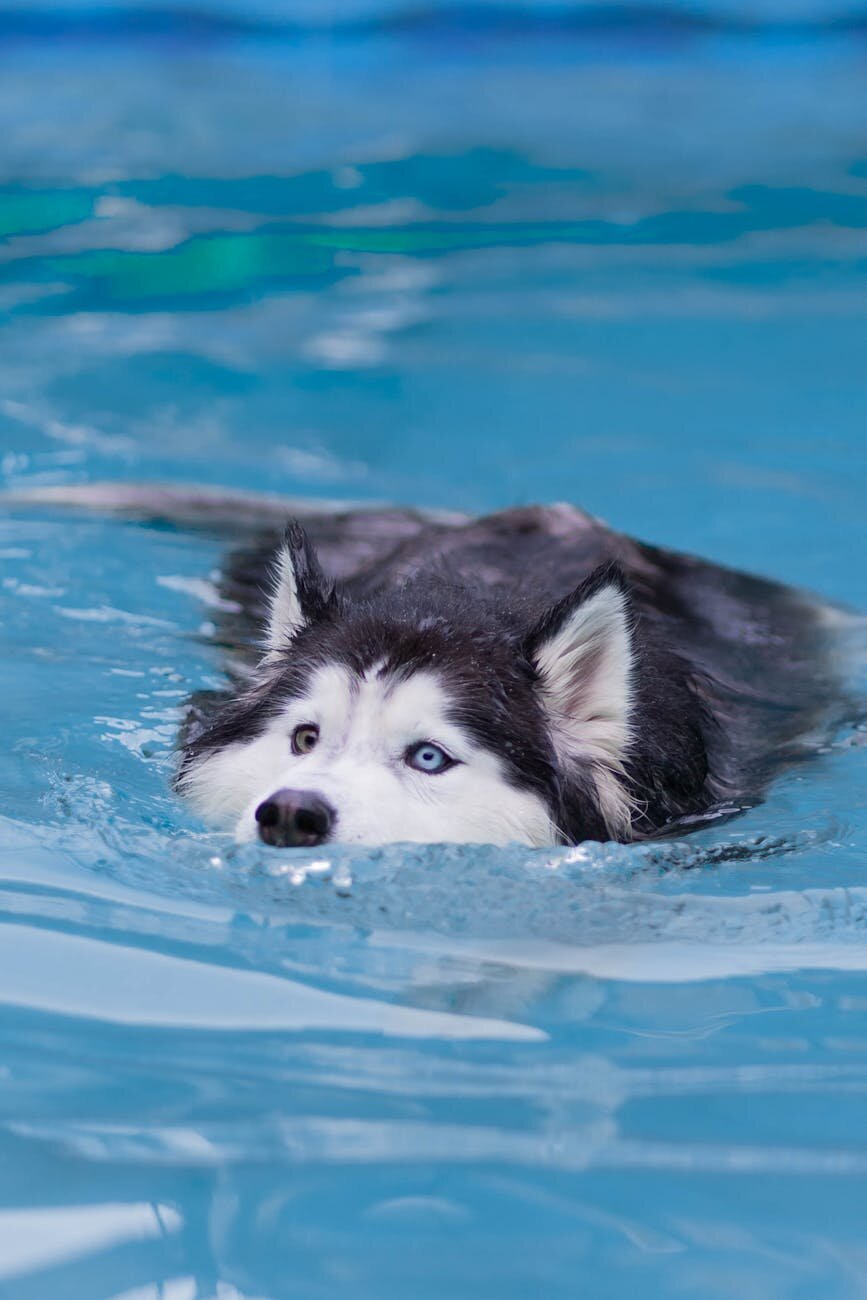Last Updated: 13/11/2025
Heatstroke in Dogs: A Vet's Guide to Signs, Treatment & Prevention
Summer fun can turn dangerous if your dog overheats. Learn to recognise the signs of heatstroke, a medical emergency that can be fatal. Our vet explains how to prevent it and what to do if it happens, ensuring your dog stays safe during the hot months.
Author: Dr Brittany Ward BVSc
Reading Time: 13 minutes - short read
Summer days are perfect for making memories with our dogs, from fun at the beach to festive family gatherings. However, it's vital to remember that our canine friends are more vulnerable to the heat than we are. A fun day out can quickly become dangerous if a dog overheats, leading to heatstroke - a serious and life-threatening medical emergency.
To help you keep your furry companion safe, this article provides a vet's guide to heatstroke in dogs. We'll explain how it happens, the critical signs to look for, and the essential steps you can take to prevent it, ensuring a happy and healthy summer for everyone.
What is Heatstroke?

Heatstroke, also known as hyperthermia, is a dangerous increase in a dog's body temperature above the normal range. Understanding the basics is key to prevention.
- Normal body temperature: A healthy dog's temperature is typically between 38.0C and 39.0C.
- When it becomes dangerous: A body temperature exceeding 41.1C is a critical emergency. At this point, organ failure can begin, and neurological symptoms may appear.
- How dogs cool down: Unlike humans who sweat efficiently, dogs primarily cool themselves by panting. They have only a small number of sweat glands located in their paw pads.
- The limits of panting: Panting is a form of evaporative cooling, but it becomes less effective as humidity rises. In high humidity (over 80%), panting can actually generate more heat than it removes. This process also leads to water loss, which can cause dehydration.
- A rapid emergency: Heatstroke can progress incredibly quickly and may become fatal in as little as 15 minutes. Every second counts; the longer a dog's temperature remains elevated, the higher the risk of severe, long-term health problems or death.
Hyperthermia is classified into three categories depending on its severity:
Heat Stress
- Often goes unnoticed
- Increased thirst and panting
- Dogs are still aware and able to move around
Heat Exhaustion
- More severe form of heat stress
- Dogs have significantly increased thirst, heavy panting, weakness and may collapse
- Dogs are mentally aware, but often too lethargic to respond or move around
Heatstroke
- Defined by a body temperature higher than 41C
- Organs will begin to fail and neurological dysfunction can occur
- Characterised by more severe symptoms
- Requires immediate cooling and veterinary treatment
Signs and Symptoms of Heatstroke

It is important to recognise heatstroke quickly to ensure the best outcome as it can quickly progress to death. There are a number of signs and symptoms that you can look for in your dog.
Early signs of heatstroke can include:
- Increased body temperature
- Heavy panting or difficulty breathing
- Restlessness, agitation or shade seeking
- Excessive drooling
- Change in gum colour to bright red or bluish-purple
As the condition worsens, signs can progress to include:
- Vomiting
- Diarrhoea (may include blood)
- Increased heart rate
- Lethargy or collapse
- Dizziness - may present as a staggering gait
- Confusion
- Muscle tremors
- Seizures
- Becoming unresponsive or unconscious
Causes of Heatstroke

There are many possible reasons why your dog's temperature may become elevated and any dog may be affected by heatstroke at any time of year. We can group the causes into two main categories though.
Environmental Factors
Environmental factors are those around us that affect our body temperature; such as the summer heat and humidity. Factors that can increase your dog's risk of heatstroke:
- Inadequate ventilation
- Lack of shade
- Limited access to water
- Excessive exercise
- Enclosed spaces e.g. being enclosed in a car, shed or garage
- Poor acclimatisation to the area (dogs can take up to 60 days to acclimatise to a new area)
- Being muzzled for any extended period of time, particularly with an incorrectly fitting muzzle which does not allow them to pant
Predisposing Internal Factors
Internal factors are any factor related to your dog, particularly in relation to their breed and health status. These are physical features or illnesses that may predispose your dog to heatstroke. Factors that may increase the risk of heatstroke:
- Age - puppies and senior dogs are predisposed to heatstroke
- Breed - large breed dogs and those with thick or long coats that can retain heat, such as Huskies and Pomeranians, are more likely to experience heatstroke
- Brachycephalic breeds (short-nose or flat-faced) - including French Bulldogs, Pugs and Boxers. These breeds have small, narrow nostrils, elongated soft palates and narrow airways that can make it difficult for them to self cool. They are 146% more likely to experience heatstroke compared to longer nosed breeds
- Overweight and obese dogs - fat acts as an insulator and these dogs generate excess heat during exercise, tiring more quickly
- Overly active, working and hunting dogs like Labradors and Kelpies are also predisposed, particularly if they continue to be active and exercise for prolonged periods of time or during the heat of the day
- Heart disease and neurological disorders
- Respiratory disease such as laryngeal paralysis or tracheal collapse
- Infections causing fever and seizures or tremors
What to do if you suspect your dog has heatstroke

Heatstroke can be fatal and is considered a medical emergency! Your dog requires immediate attention and the sooner they get to a vet, the better their prognosis. However, you will need to start the cooling process before transporting your dog.
Immediate First Aid
If your dog is showing any of the above signs of hyperthermia, follow the below steps to help your dog start cooling down on the way to the vet clinic.
- Remove your dog from the source of the heat and move to somewhere cool.
- Use a bucket or hose to pour water over them, avoiding their face. This water should be cooler than your dog, but NOT ice-cold.
- Place them in front of a breeze, fan or air conditioning (at room temperature). The air conditioning in your car or an open car window are great options. Air flow combined with wetting them down promotes evaporative cooling.
- Offer them water, ideally small sips.
- Call your vet to let them know you are coming in and transport your dog to the clinic, continuing the cooling methods on the way.
Heatstroke DONT'S
- NEVER use ice or ice water to cool your dog down. Ice and cold water will cause the blood vessels to constrict, retaining heat. Room temperature or cool water is best. If you are using air conditioning, this should also be kept at a comfortable, ambient temperature, such as 24-26C to avoid cooling too quickly. Cooling too quickly can cause Hypothermia.
- NEVER place a wet towel or cloth over your dog. These will absorb the heat from their body and create humidity, further raising your dog's temperature.
Veterinary Diagnosis and Treatment of Heatstroke

Your veterinarian will make a diagnosis of heatstroke following an examination based on their symptoms, a history of exposure and their body temperature. Information you provide to your vet about the events preceding your dog's symptoms can be critical for making an accurate diagnosis.
Remember that health conditions such as infection and seizures can also raise the body temperature and your vet will want to rule out these as an underlying cause for their hyperthermia.
Veterinary Treatment
Treatment of heatstroke may involve:
- Commencement or continuation of emergency cooling
- Intravenous (IV) fluids to manage dehydration, shock and cool the body internally
- Oxygen therapy
- Anaesthesia and intubation for patients with respiratory difficulties or that are unconscious
- Gastroprotectants or anti-nausea medications for patients with vomiting and/or diarrhoea
- Antibiotics may also be given to prevent a secondary infection
- If required, your vet may also use cardiac medications
Once cooling is in effect, your vet may recommend blood tests to assess the level of dehydration, look for clotting issues, assess organ function and determine the success of treatment. Prolonged hyperthermia can lead to clotting disorders and internal bleeding, so it is important to assess for these. If your dog has developed clotting problems, a blood or plasma transfusion may be required.
Recovery and management post heatstroke
After initial cooling, your pet will be hospitalised for close observation and supportive care. Depending on the severity, they may need to be treated in an Intensive Care Unit (ICU).
Early diagnosis and aggressive treatment are the most important factors in determining the prognosis.
How heatstroke affects the body
- A core body temperature above 41C can cause essential proteins in the body's cells to break down (denature)
- This widespread cellular damage can lead to multiple organ failure and systemic shock
- The higher the body temperature and the longer the exposure, the more severe the internal damage will be
Prognosis and recovery
- Heatstroke is a life-threatening emergency and, unfortunately, the prognosis is often poor. It can be fatal or cause permanent damage despite treatment
- The first 24 hours of treatment are the most critical. Pets that survive this initial period are likely to recover
- Most surviving pets recover fully without long-term complications
- A hospital stay typically lasts for 2-3 days, but can be up to a week for more severe cases
Care after your pet comes home
- Your pet will need plenty of rest in a cool, comfortable environment for at least two weeks after being discharged
- Your vet may recommend follow-up blood tests 1-2 weeks later to check for any lasting organ damage and determine if ongoing care is needed
Long-term risks
- A pet that has experienced heatstroke is more susceptible to it happening again
- The condition can damage the part of the brain that regulates body temperature, meaning they may not be able to cool themselves down as effectively in the future
- For these pets, ongoing prevention and vigilance during warm weather are even more important.
Preventing Heatstroke

Preventing heatstroke is all about keeping your pet cool! Prevention is important for all dogs, but especially if you have a high risk breed. Here are some simple tips for preventing heatstroke in your dog.
- Never leave your pet in a parked car
- Never leave your pet inside a hot closed house or garage
- Plan your trips to keep your car cool and provide water
- Ensure your dog always has access to cool, fresh water
- Encourage your dog to stay hydrated
- Ensure your dog always has access to shade
- Keep your dog in a well ventilated area
- Walk your dog in the morning or late evening when it is cooler - especially brachycephalic breeds
- Avoid walking on hot surfaces, such as sand, bitumen and concrete
- Get dogs with long coats, like Poodles, clipped to prevent heat retention
- Groom your dog, especially long haired breeds, regularly to remove loose fur and prevent matting
- Provide access to cooling, such as water, cooling mats, and cooling vests
Use cooling mats and gear
A variety of clever products can help keep your dog comfortable on hot days, which is especially useful if you're not there to supervise them.
Providing enrichment and exercise
Even though it is hot out, your dog still needs plenty of mental and physical stimulation to prevent them resorting to destructive behaviours for entertainment. So what activities can you do without risking heatstroke?
Scent Games
Scent games are a great indoor activity that is mentally challenging for your dog and a lot of great fun to play! Dogs love to engage in this kind of training as it simulates their natural hunting instincts and it's a great way to strengthen your bond with your dog. There are lots of scent game options, such as Seek, Find The Food and Identify the Smell, you just have to start searching and training. Who knows, your dog may even be able to find your house keys next time you lose them!
Swimming
Why not try swimming? Swimming is an excellent summer activity. Avoid going in the hottest part of the day or use a pool that has been kept in the shade to help your dog cool down. Swimming is also great for assisting weight loss and providing low impact exercise for arthritis.
Keep in mind if you have a Brachycephalic, or pushed in face, breed, swimming may not be a safe activity for them. Dogs will need to hold their head above water to continue to breathe while swimming, but for Brachycephalic breeds this may reduce their airflow. Water play with a sprinkler or a shallow body of water would be a great, safer alternative.
Interactive Toys and Puzzles
Puzzles and interactive toys are the perfect way to keep your dog occupied while they are cooped up on a hot day. These activities provide mental stimulation, which is more tiring than physical activity, as well as gentle exercise. They can keep your dog distracted for an extended period of time, within the comfort of your own home or in a shaded area of the yard.
For more information about the range of puzzle toys available, how to use them and their benefits, check out our articles Boredom Busters for Dogs and The Benefits of Puzzle Feeders.
Ice and Frozen Treats
Have you ever given your dog an ice-cube before? Ice-cubes can be a very interesting object for dogs. Not only can they be used to cool their water and mouth down, but they can also be great toys! Many dogs will initially be curious and investigate the ice-cube. They may also try to play with it, biting at it, pawing at it and chasing it as it goes skidding across the ground.
Frozen treats are also a great option for providing mental stimulation that helps to keep your pet cool. You could fill a Kong or lickmat with your pup's favourite wet food or paste treat to provide engaging, and cooling enrichment throughout the heat of the day.
If you are looking for some great lickmat fillers and frozen treat ideas, check out our Homemade Summer Recipes.
FAQs
Heatstroke is a serious concern in our dogs, especially as the temperatures continue to rise throughout Summer. It is a medical emergency requiring immediate treatment. First aid cooling can be started, but all dogs showing signs of heatstroke will need to see the vet. This rapidly progressing condition could result in permanent health problems or heartbreak.
Prevention is essential during the warmer months and in at risk breeds to reduce the risk of it occurring. Learning the signs of heatstroke, first aid treatment and how to prevent it, could save your pet's life!
References
Heat Stroke in Dogs - VCA Hospitals - https://vcahospitals.com/know-your-pet/heat-stroke-in-dogs
Heat Stroke in Dogs - Animal Emergency Services - https://animalemergencyservice.com.au/blog/heat-stroke-in-dogs/
Heatstroke in Dogs and Cats - Royal Veterinary College - https://www.rvc.ac.uk/small-animal-vet/teaching-and-research/fact-files/heatstroke-in-dogs-and-cats
Heatstroke in Dogs - PetMD - https://www.petmd.com/dog/conditions/systemic/heatstroke-dogs
Today's Technician Heatstroke in Dogs - https://todaysveterinarypractice.com/emergency-medicine-critical-care/todays-technician-heatstroke-in-dogs/
What You Need to Know About Heatstroke in Dogs - https://www.sydneyvetspecialists.com.au/what-you-need-to-know-about-heat-stroke-in-dogs/
Articles recommended for you
Our vet authored guide to the benefits of feeding your dog fresh food plus tips and advice for introducing it into their regular menu.
See our guide to protecting your pet from parasites from our vet team.
Thinking of getting a fish? Check out our guide for setting up a tank and home care tips!
Looking to understand horse feeds better? This comprehensive guide covers feeding recommendations for horses of all ages and disciplines.
Does your pet suffer from anxiety? Check out our Vet-guide for treatment options to help your pet.
History
Our experts continually monitor the health and wellness space and we update our articles when new information becomes available.
Tue 23 Sep 2025
Edited by Dr Gillian Hill BVSc (Hons)Dr Brittany Ward BVSc
Veterinarian
Dr. Brittany graduated from James Cook University in 2019 with a Bachelor of Veterinary Science and started working in her home town in the Wide Bay-Burnett Region. She has always been excited about working in the veterinary industry, but over the last few years has grown especially fond of dog behaviour and training, surgery and orthopaedic disease.

